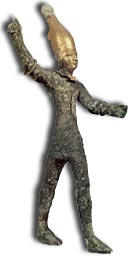
Baal
Symbols: bull, cedar tree
Cult Center: Baal-Saphon, Memphis
During the New Kingdom, as Egypt began expanding its empire into the Near East, several gods local to that region began to be worshipped by Egyptians. Among these foreign gods were Qetesh, Reshep and Baal. Baal was a western Semitic god of storms and the skies whose worship in Egypt was established by the 18th Dynasty. By 1400 B.C., he was an important god to the Canaanites and was mentioned in the Hebrew Bible as a competitor with God for the affections of the Israelites. The Bible described Baal as killing and eating human beings (Jeremiah 19).
According to Near Eastern mythology, Baal destroyed Yam, the god of the Great Green (the Mediterranean Sea). Baal himself was killed later by Mot, the Semitic god who personified death. Baal's sister and consort, Anat, resurrected him. Anat was a warrior-goddess who went on to avenge Baal's murder by cleaving Mot with her sword, throwing his body into a fire, then grinding his bones and feeding the remains to the birds and animals of the fields.
Baal and Anat were also said to have mated while in the guise of a bull and a cow.
Despite the obvious parallels between Baal's murder and resurrection and Osiris's murder and resurrection by his sister Isis, a connection between the two gods was not made by Baal's worshippers in Egypt. Rather, Baal was commonly identified with Osiris's murder, Seth. Seth and Baal were both gods of storms. In the narratives of the Battle of Kadesh, Pharoah Rameses II was called "Seth, great of strength, and Baal himself."
Baal was depicted as a powerful warrior with a curved, Syrian-style, beard. He wore a horned helmet and carried various weapons, including a sword, a club made from a ceder tree, or a thunderbolt.
Digg This!
![]() Del.icio.us
Del.icio.us
![]() Stumble Upon
Stumble Upon
